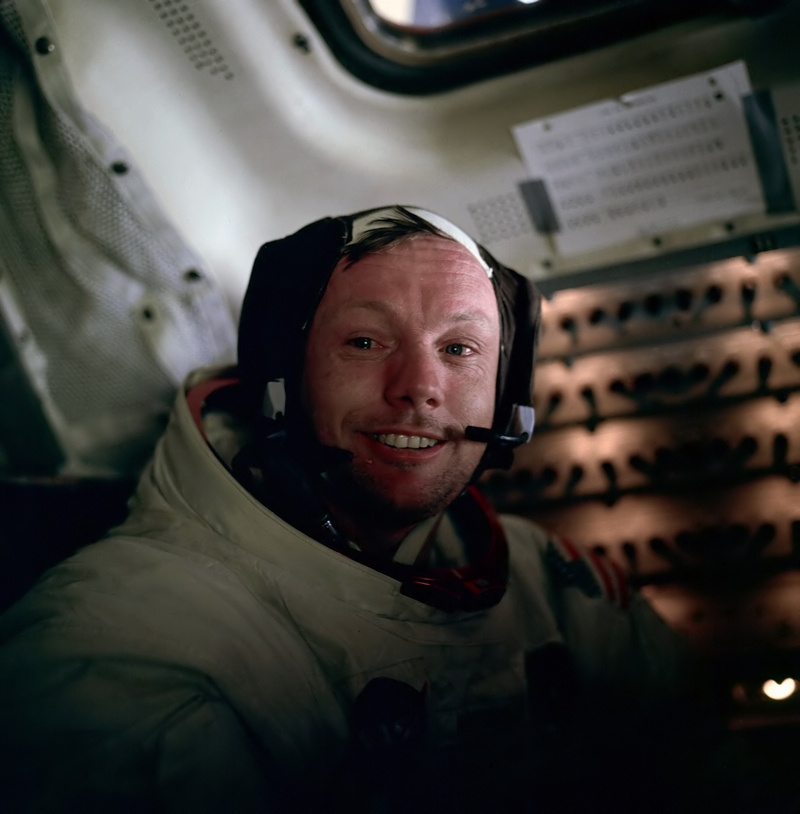
Five years ago, a man died who left the first marks on the moon - that is how he was remembered for most people on the planet. Few people know that he was also the pilot of the prototype of the lunar module (
LLRV ), and the first person to carry out the manual docking of spacecraft (during the
Gemini 8 mission), a test pilot, and a deck pilot. And every time - his life "hung in the balance."
Childhood, study and military service
Armstrong was born on August 5, 1930, in the family of an auditor - so the family often moved: for his childhood, the family changed 20 cities. Nile's love for the planes was manifested at an early age, after his father took him to the
National Air Races at two years old, and at the age of five (in 1936), he had the opportunity to fly himself.
In 1944 (at the age of 14), after the death of his father, he entered the flight school of his city. And already on his 16th birthday, he received a pilot's license (earlier than a driver’s license). The following year, he entered the
Purdue University Bachelor's Degree in Aviation Engineering, under an agreement with the Navy (which paid for his training). Under the contract, after two years of study at the university, and an additional two years of flight training, he had to serve a year in the US Navy.
After studying at the university, he arrived on January 26, 1949 for flight training, which he completed on August 16, 1950 - two weeks after his 20th birthday, receiving the title of deck pilot. And already in 20 and a half years (January 5, 1951), he made the first landing on
the Essex aircraft carrier on the
Grumman F9F Panther aircraft.
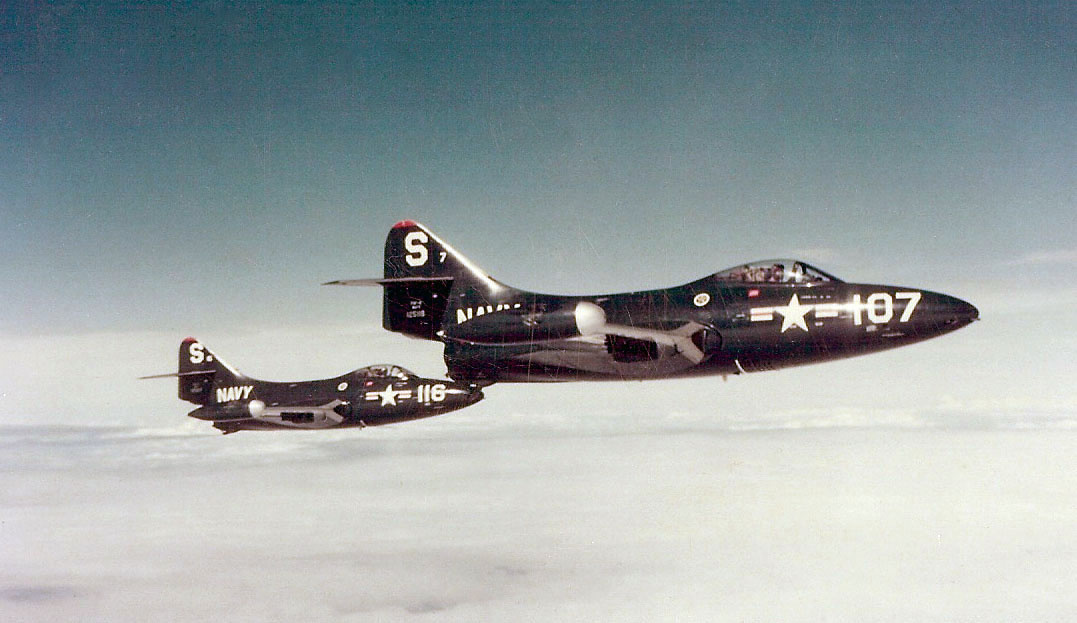
His aircraft carrier was sent to South Korea, where at that moment there was a
Korean war . Five days after the first flight, his F9F-2 was hit by anti-aircraft fire, and a piece about a meter long fell off from the right wing. The plane partially retained controllability, and managed to reach the friendly territory, but because of the loss of the ailerons, he had no other chance to eject. When he landed, he was picked up by a jeep driven by his roommate in a flight school. In total, he made 78 sorties in Korea for 121 hours, after which he left the navy on August 23, 1952.
Next, Neil returned to school, and in 1955 received a bachelor of science degree in aeronautical engineering, after which he decided to become a test pilot. He applied to the High-speed flight station (now known as the
“Flight Research Center named after Armstrong” ) under the auspices of
NACA (predecessor of NASA). But at that moment there were no vacant places, so from March to July 1955 he was sent to the Lewis flight propulsion laboratory (now known as the Lewis Space Research Center).
Career Test Pilot
Here he flew on different models of aircraft, one of which was the
B-29 "Superfortress" (a descendant of the "Flying Fortress" of the Second World War). During the departure of March 22, 1956 on this plane (as a co-pilot), he had to drop the
D-558-2 Skyrocket rocket-jet aircraft, suspended under the fuselage, at a given height.
During the ascent, at the height of 9 km, the 4th engine stopped, after which its propeller began to rotate under the action of incoming air. Pilots needed to stop its rotation with a toggle switch (excessive acceleration of the propeller threatened to destroy it), but after a short deceleration, the propeller began to unwind again. They made a decision to drop the “Skyrocket”, and to make an emergency landing (as they couldn’t sit with the plane suspended):
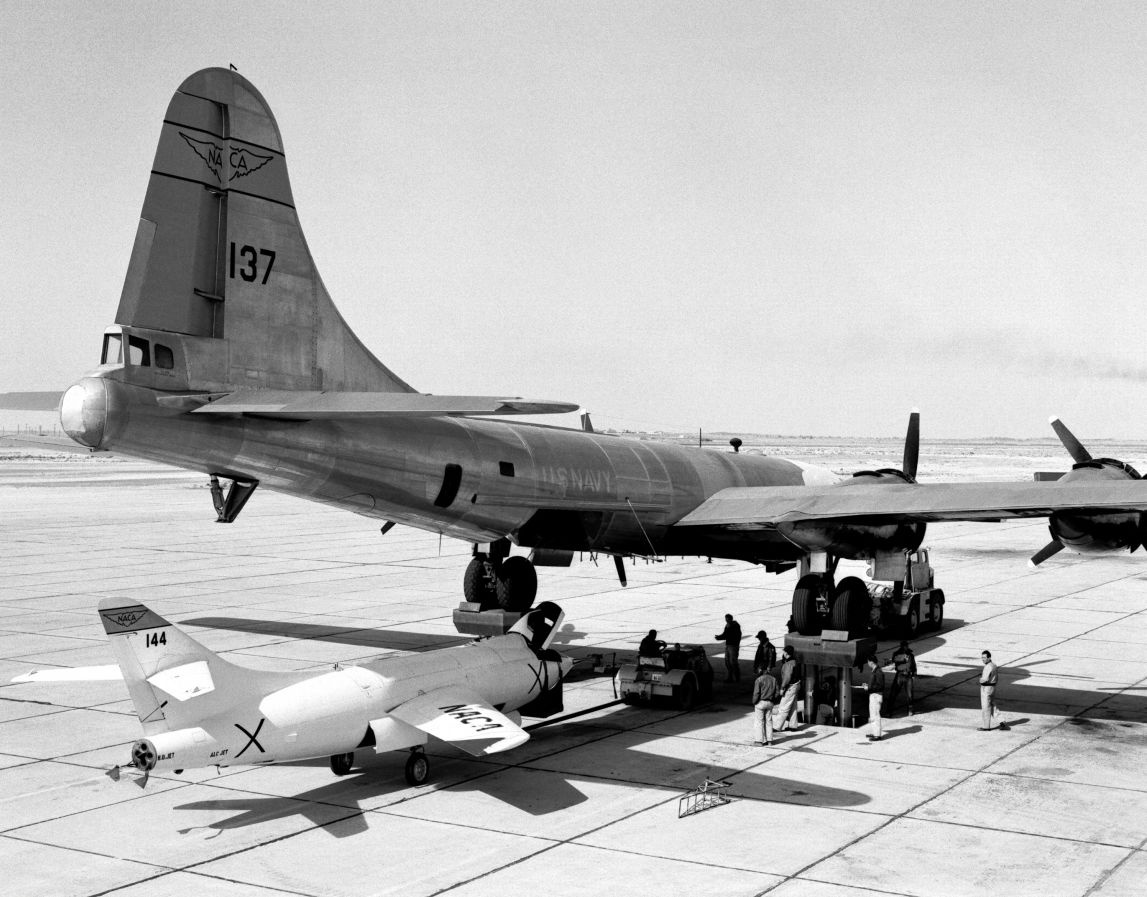
They lowered the nose of the aircraft to pick up the speed necessary to reset the "Skyrocket", and at the time of separation - the propeller of the 4th engine collapsed. Wreckage of the propeller damaged the 3rd engine, and hit the 2nd, the pilots also had to turn off the 1st engine to compensate for the torque. They performed a slow circling descent (in a spiral), and landed safely.
As a test pilot, he participated in the tests of the F-100 Super Saber A and C, F-101 Voodoo, F-104A Starfighter, and on August 15, 1957, he had the opportunity to fly the famous
Bell X-1B (a later modification of the aircraft that first overcame sound barrier), in which the landing gear broke down in the process of landing (what happened to this plane earlier). He also conducted 7 sorties from November 1960 to July 1962 on an experimental
X-15 rocket plane , which reached an altitude of 63.2 km (below
the Karman line ), and a speed of 5.74
Mach .
In 1958, he was selected for a
program to launch a US astronaut into space before a Soviet cosmonaut, but already on August 1 of the same year, the program was disbanded in favor
of the Mercury program , and on October 1, the
NACA (National Aeronautical Advisory Committee) converted to
NASA (still existing). Of those nine volunteers, only two were destined to reach space:
Joseph Walker and Neil Armstrong, and only one (Neal) managed to get to Earth's orbit.
In November 1960, he was selected as one of the 7 pilots on the
X-20 Dyna-Soar program , which was also subsequently closed. Of this group in space, Nil alone turned out to be: even though
William Dana was recognized by NASA as an astronaut 39 years after his flight over 50 miles (considered space bound in the USA) on X-15, he still failed to cross the Karman line ( common boundary of space).
Astronaut's career as an astronaut was saved by Armstrong from the X-20 Dyna-Soar program - he managed to apply for
the Apollo program a week before the deadline for accepting applications (scheduled for June 1, 1962). The X-20 Dyna-Soar program was closed on December 10, 1963, when NASA's
3rd set was already completed, in the 4th - only scientists were recruited, and before
the 5th - it was another 2.5 years.
Djemeni-8
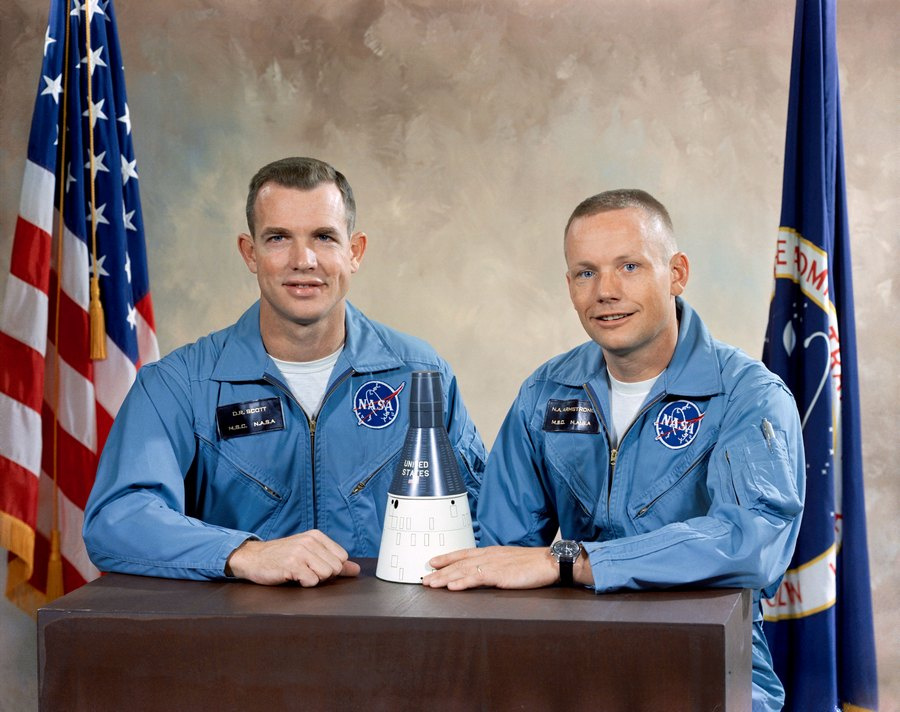
On September 20, 1965, he was assigned to the
Gemini 8 mission in which they were to do the first docking of the spacecraft for the US (and the first manual in the world), and his partner,
David Scott , to perform the second astronaut in the US. The whole operation should have taken 75 hours.
Agena was launched into orbit on March 16, 1966, at 15:00
UTC on the Atlas rocket. About two hours later, after making sure that she was in the correct orbit, the manned Gemini-8 was launched on the Titan 2 rocket. The automatic approach system radar "Ajenu" from a distance of 332 km, and the system led Gemini-8 at a distance of 46 meters to the module, and after a half-hour inspection (which is all right with the module), Armstrong carried out the docking at 22.14 of the same day.
Almost immediately after the docking, Agena executed the command for a 90 ° turn (stored in her memory), as a result of which the bundle began to rotate. Armstrong issued a command to Gemini-8 engines to redeem the rotation, but it immediately began to grow again. Noticing the drop in fuel in the orientation tanks up to 30%, they realized that the problem was that one of its engines had not turned off. They undocked from Agena (in which there was a lot of fuel, and which could collapse under the action of rotation), gave an impulse to move away from it, and completely turned off the engines of orbital orientation.
After that, they manually extinguished the rotation of the engines of landing orientation (which took almost 75% of the fuel supply of the system). During the accident, the rotation frequency reached 1 rev / s, the overload - 3.5 g, and the astronauts showed the effect of
tunnel vision , which threatened to completely lose consciousness. Due to the loss of most of the fuel - the exit into space had to be canceled, and instead of 75 hours - their mission ended abnormally after ten and a half.
He was further assigned as an assistant during the preparation of the Gemini-11 reserve team, and served as
CAPCOM during the mission (this is the only person who is associated with astronauts on behalf of the
MCC — in the US, acting astronauts are often chosen for this role). After this mission, President Lyndon Johnson asked him and his wife to go on a tour with him to 11 countries.
Apollo Program
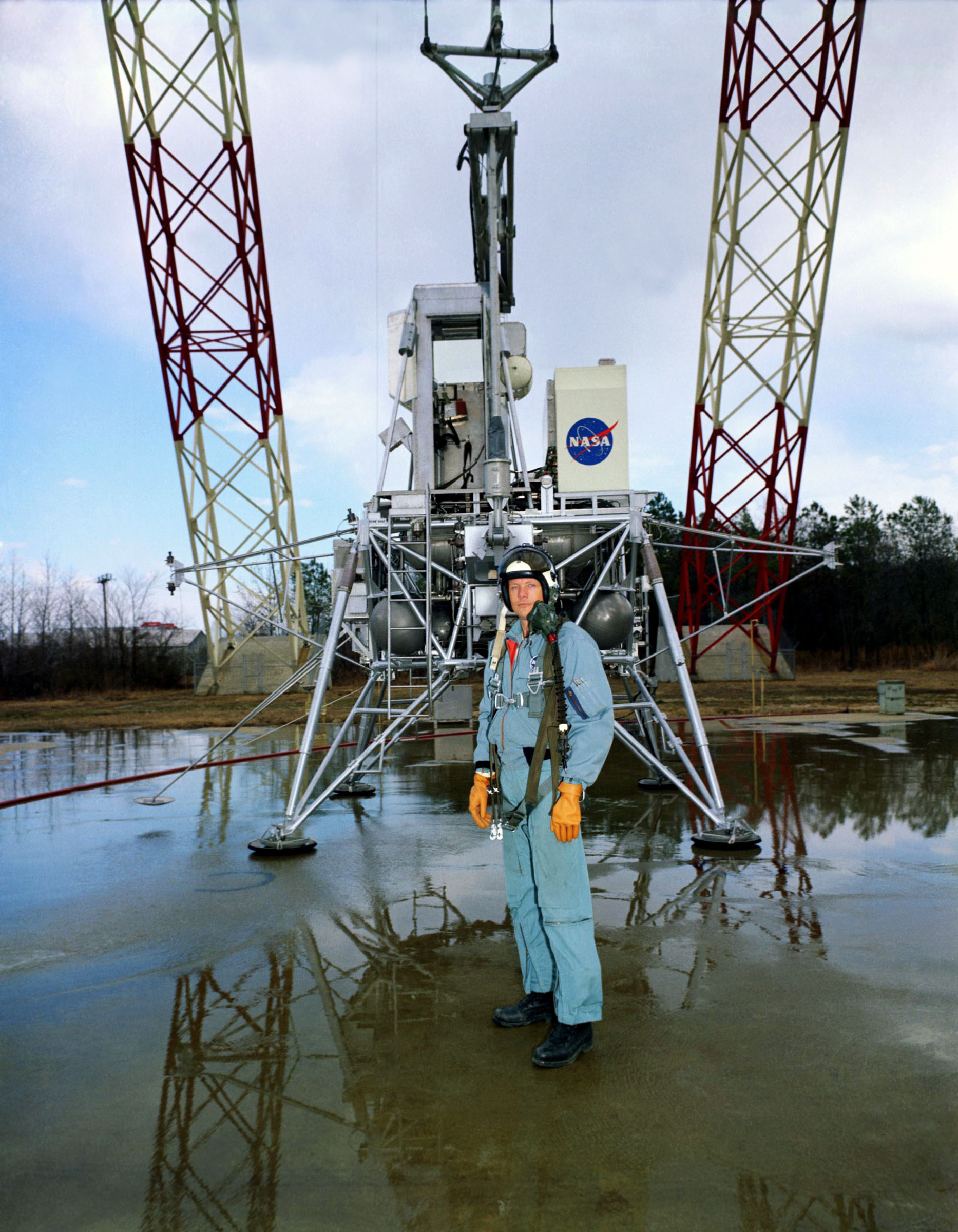
In preparation for the landing on the moon, the pilots were required to work out a vertical landing, so NASA ordered two test and three training aircraft to test the lunar landing (
LLRV and LLTV ) from
Bell Aircraft Corporation . For their appearance, unlike any other aircraft, they got the nickname “flying beds” (a
similar device appeared here earlier, but it was used to practice landing the
YAK-38 deck attack aircraft on the deck of an aircraft carrier, and not landing on the Moon , but got a similar nickname - “the flying table”).
During the flight on May 8, 1968, the vehicle lost controllability and crashed. Armstrong managed to eject 1.5 seconds before the collision with the ground. After the accident - as if nothing had happened, he went to the office for the rest of the day to do paperwork.
After being appointed commander of the Apollo 8 reserve team, he was appointed to the Apollo 11 crew (also commander) on December 23, 1968, in accordance with the standard staff rotation. However, the decision that Armstrong would be the first to come to the surface was made only in March 1969; one of the reasons was his lack of a big ego.
At a press conference on April 14, it was officially approved. The reason was the fact that the commander of the
lunar module (
Buzz Aldrin ), who is sitting at the exit, is harder to get out, as the door opens to the inside. This decision, perhaps, almost cost both astronauts life: leaving the lunar module, Armstrong hooked his bulky spacesuit toggle switch, which had to start the take-off engine. The mission was saved by a felt-tip pen that was in Aldrin’s pocket in a spacesuit pocket. A broken toggle switch, and that felt-tip pen - Aldrin keeps still.
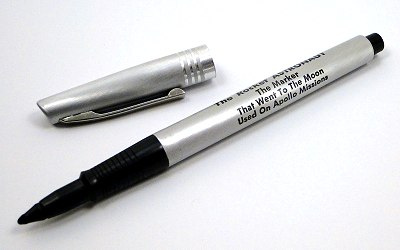
During the descent over the moon, they determined that they had flown several kilometers over the proposed landing site. The module's computer produced two errors, but after communicating with the MCC, it turned out that they were not dangerous, and the landing could continue. There were many stones at the proposed landing site, Armstrong decided to switch the landing to manual mode, and look for another place. At the time of landing - they had fuel for less than 30 seconds of normal work (another 20 seconds of emergency reserve were allocated for the launch of the take-off module, in case of cancellation of the landing). During this process, Armstrong's pulse reached a peak of 160 beats per minute (although even at the start of Saturn-5, it did not rise above 110 beats).
This is one small step for man, but a giant leap for all of humanity. ”
According to estimates, Neil Armstrong heard this phrase live on the air of 450 million people (out of 3.6 billion people living at that time) worldwide, with the exception of China and the USSR. After his return and 18 days of quarantine, he visited 25 countries in 35 days, including the USSR:
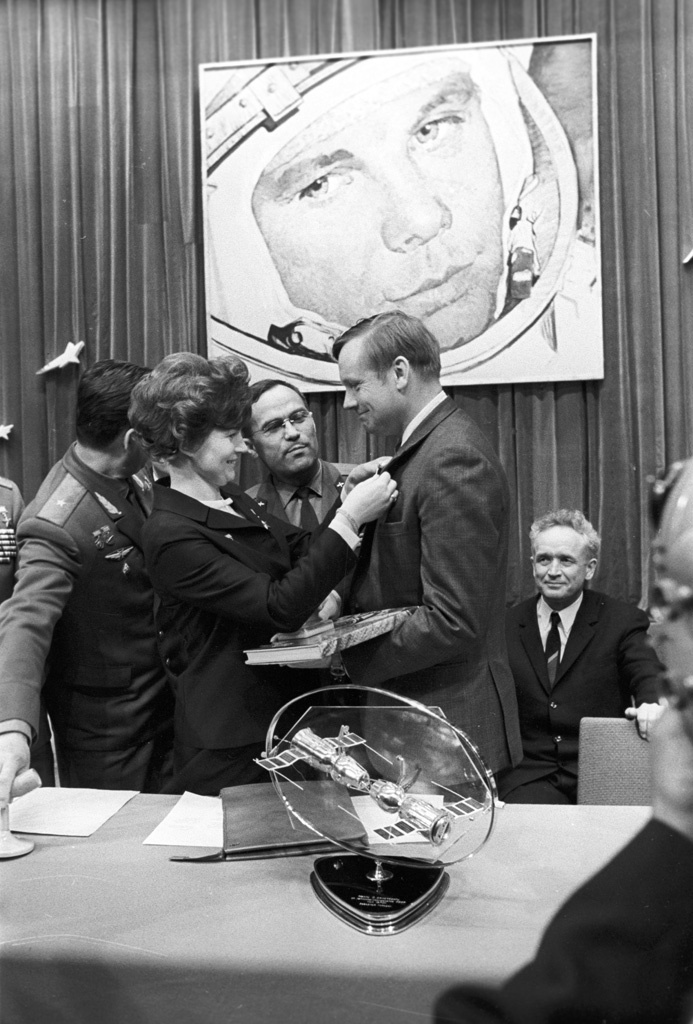
Soon after, he announced that he was not going to fly into space anymore. He was appointed deputy director of aviation at ARPA (now known as
DARPA ), but left the place to work there for only a year. In 1970, he received a Master of Science degree and was appointed a professor of aerospace science at the University of Cincinnati, where he worked for 8 years (until 1979).
After retiring from NASA in 1971, he worked as a chairman in several commercial firms, and even starred in an advertisement for Chrysler. He returned to NASA twice: for investigations into
the Apollo 13 crash, and the
Challenger shuttle crash. In 1985, he visited the North Pole, including
Edmund Hillary and
Steve Fossett . The last years of his life he spent on his farm in Ohio, spending his free time flying on a glider.
During his career, he flew more than 200 models of airplanes, helicopters and gliders; and also was the holder of 40 world records in aviation and astronautics.